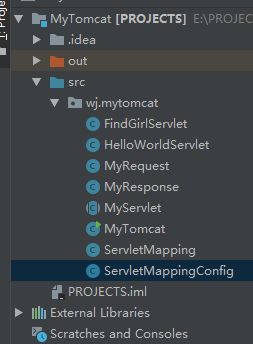手写一个Tomcat
(参考了公众号:java架构沉思录中的文章:教你写一个迷你版的tomcat
原文:https://www.jianshu.com/p/dcelee01fb90)
作为一个java学习的起步者,对tomcat的认识还是有很多的欠缺,在无意中发现了这篇文章,便在自己的环境下尝试搭建,收获良多:
分以下几个步骤:
(1)提供Socket服务
(2)进行请求的转发
(3)把请求和响应封装成request/response
代码实现如下:
1、工程截图:

2、封装请求对象:通过输入流,对HTTP协议进行解析,拿到了HTTP请求头的方法和URL:
/**
* @author wangjie
* @version 2018/11/9
* 封装请求对象
* 通过输入流,对http协议进行解析,拿到http请求头的方法和url
*/
public class MyRequest {
private String url;
private String method;
public MyRequest(InputStream inputStream) throws IOException{
String httpRequest ="";
byte[] httpRequestBytes =new byte[1024];
int length =0;
if((length=inputStream.read(httpRequestBytes)) >0){
httpRequest=new String(httpRequestBytes,0,length);
}
String httpHead = httpRequest.split("\n")[0];
url=httpHead.split("\\s")[1];
method=httpHead.split("\\s")[0];
System.out.println(this);
}
public String getUrl() {
return url;
}
public void setUrl(String url) {
this.url = url;
}
public String getMethod() {
return method;
}
public void setMethod(String method) {
this.method = method;
}
}
3、封装响应对象:基于HTTP协议的格式进行输出写入。
/**
* @author wangjie
* @version 2018/11/9
* 封装响应对象
* 基于HTTP协议的格式进行输出写入。
*/
public class MyResponse {
private OutputStream outputStream;
public MyResponse(OutputStream outputStream){
this.outputStream = outputStream;
}
public void write(String content)throws IOException {
StringBuffer httpResponse = new StringBuffer();
httpResponse.append("HTTP/1.1 200 OK\n")
.append("Content-Type: text/html\n")
.append("\r\n")
.append("")
.append(content)
.append("");
outputStream.write(httpResponse.toString().getBytes());
outputStream.close();
}
}
4、servlet请求处理基类:Tomcat是满足Servlet规范的容器,所以Tomcat需要提供API:doGet/doPost/service。
/**
* @author wangjie
* @version 2018/11/9
* Servlet请求处理基类
*/
public abstract class MyServlet {
public abstract void doGet(MyRequest myRequest,MyResponse myResponse);
public abstract void doPost(MyRequest myRequest,MyResponse myResponse);
public void service(MyRequest myRequest,MyResponse myResponse){
if(myRequest.getMethod().equalsIgnoreCase("POST")){
doPost(myRequest,myResponse);
}else if(myRequest.getMethod().equalsIgnoreCase("GET")){
doGet(myRequest,myResponse);
}
}
}
5、Servlet实现类:提供2个实现类,用于测试。
/**
* @author wangjie
* @version 2018/11/9
* servlet实现类
*/
public class FindGirlServlet extends MyServlet{
@Override
public void doGet(MyRequest myRequest,MyResponse myResponse){
try{
myResponse.write("get gril....");
}catch (IOException e){
e.printStackTrace();
}
}
@Override
public void doPost(MyRequest myRequest,MyResponse myResponse){
try{
myResponse.write("post girl...");
} catch (IOException e){
e.printStackTrace();
}
}
}
/**
* @author wangjie
* @version 2018/11/9
*/
public class HelloWorldServlet extends MyServlet {
@Override
public void doGet(MyRequest myRequest,MyResponse myResponse){
try{
myResponse.write("get world...");
}catch (IOException e){
e.printStackTrace();
}
}
@Override
public void doPost(MyRequest myRequest,MyResponse myResponse){
try{
myResponse.write("post world...");
}catch (IOException e){
e.printStackTrace();
}
}
}
6、Servlet配置:对比之前在web开发中,会在web.xml中通过和指定哪个URL交给哪个servlet来处理。
/**
* @author wangjie
* @version 2018/11/9
* servlet配置
*/
public class ServletMapping {
private String servletName;
private String url;
private String clazz;
public ServletMapping(String servletName, String url, String clazz){
this.servletName=servletName;
this.url=url;
this.clazz=clazz;
}
public String getServletName() {
return servletName;
}
public void setServletName(String servletName) {
this.servletName = servletName;
}
public String getUrl() {
return url;
}
public void setUrl(String url) {
this.url = url;
}
public String getClazz() {
return clazz;
}
public void setClazz(String clazz) {
this.clazz = clazz;
}
}
/**
* @author wangjie
* @version 2018/11/9
*/
public class ServletMappingConfig {
public static List servletMappingList =new ArrayList<>();
//制定哪个URL交给哪个servlet来处理
static{
servletMappingList.add(new ServletMapping("findGirl","/girl","wj.mytomcat.FindGirlServlet"));
servletMappingList.add(new ServletMapping("helloWorld","/world","wj.mytomcat.HelloWorldServlet"));
}
}
7、启动类:
tomcat的处理流程:把URL对应处理的Servlet关系形成,解析HTTP协议,封装请求/响应对象,利用反射实例化具体的Servlet进行处理。
/**
* @author wangjie
* @version 2018/11/9
* tomcat启动类
*/
public class MyTomcat {
private int port=8088;
private Map urlServletMap =new HashMap();
public MyTomcat(int port){
this.port=port;
}
public void start(){
// 初始化URL与对应处理的servlet的关系
initServletMapping();
ServerSocket serverSocket=null;
try{
serverSocket = new ServerSocket(port);
System.out.println("MyTomcat is start...");
while(true){
Socket socket= serverSocket.accept();
InputStream inputStream=socket.getInputStream();
OutputStream outputStream=socket.getOutputStream();
MyRequest myRequest= new MyRequest(inputStream);
MyResponse myResponse =new MyResponse(outputStream);
// 请求分发
dispatch(myRequest,myResponse);
socket.close();
}
}catch (IOException e){
e.printStackTrace();
}finally {
if (null != serverSocket){
try{
serverSocket.close();
}catch (IOException e){
e.printStackTrace();
}
}
}
}
private void initServletMapping(){
for(ServletMapping servletMapping:ServletMappingConfig.servletMappingList){
urlServletMap.put(servletMapping.getUrl(),servletMapping.getClazz());
}
}
public void dispatch(MyRequest myRequest,MyResponse myResponse){
String clazz =urlServletMap.get(myRequest.getUrl());
//反射
try{
Class myServletClass =(Class) Class.forName(clazz);
MyServlet myServlet= myServletClass.newInstance();
myServlet.service(myRequest,myResponse);
}catch (ClassNotFoundException e){
e.printStackTrace();
}catch (InstantiationException e){
e.printStackTrace();
}catch (IllegalAccessException e){
e.printStackTrace();
}
}
public static void main(String[] args){
new MyTomcat(8088).start();
}
}
8、测试:
运行项目后,在浏览器输入:localhost:8088/girl

在浏览器输入:localhost:8088/world

实践完成。